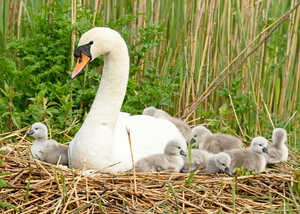A seasonal highlight for families, nature lovers and curious minds
Each spring, something quietly magical unfolds along the shores of the Fleet Lagoon. Between late April and early June, Abbotsbury Swannery comes to life with the arrival of hundreds of cygnets – the downy, grey offspring of the colony’s Mute Swans. This short season draws visitors from across Dorset and beyond, and has become one of the most looked-forward-to moments in the Swannery calendar.

A brief window to see the youngest residents
May and June are the best times to visit
If you’re planning things to do in Dorset today or over the next few weeks, a visit during cygnet season is well worth adding to your list. By mid-May, the first eggs begin to hatch across the site. With over 100 nesting pairs in close proximity, the hatching continues well into June. Visitors can see young swans up close, exploring the reed beds and resting beside their parents.
The setting allows you to walk near the nesting areas without disturbing the birds. Because of the way the colony is managed, this part of the swan’s life cycle is visible and easy to appreciate, even on a short visit.

Why this time of year stands out
A rare opportunity to see cygnets up close
Seeing swans with their young is something many people hope to experience once in their lives. From newly hatched cygnets to slightly older ones finding their feet, there is always movement and interest around the nests here at Abbotsbury.
Children often stop in their tracks to watch the cygnets trail behind their parents or paddle gently across the water. For many visitors, these early summer weeks leave a lasting impression, especially if it’s their first time seeing a colony this large and active.
Why the Swannery is so well suited to cygnets
A natural haven for new life
The Fleet Lagoon provides fresh water and food, both essential for raising young swans. The reeds growing along the shore are ideal nesting material and are also harvested and maintained as part of the Swannery’s wider conservation work.
Most nesting sites for Mute Swans are more isolated, with pairs spaced far apart. Here, the birds nest in a colonial style, with dozens of pairs sharing the same stretch of protected water. It’s a rare behaviour, and one that allows visitors to see a wide variety of interactions across the site.

Making the most of a visit with children
Feeding time and family-friendly activities
The Swannery holds daily mass feedings at midday and 4pm. These provide an opportunity for visitors to observe the swans gathering, with members of the team offering background on the colony and answering common questions.
Children can often help with the feeding, making it a popular activity for families. Alongside the swan interactions, the living willow maze and the Brambly Hedge Summer Story Trail provide plenty of variety throughout the day. The setting is calm and easy to navigate, with good facilities and space to pause.

Ideal timing for holidays, weekends and days out
Planning your early summer trip
If you’re searching for the best things to do in Dorset during May or June, cygnet season is a highlight that fits all ages. These early summer weeks often provide the best weather for visiting, and the young swans are at their most visible before they grow large and move further out across the lagoon.
Booking in advance is simple and flexible, and combining your visit with the nearby Subtropical Gardens offers a full day of activity and nature. Many families choose to return year after year, especially during half-term or weekends.

See the youngest swans begin their journey
A peaceful and memorable experience
Cygnet season marks the start of the year’s life cycle at Abbotsbury Swannery. It’s a peaceful time, filled with quiet moments and small discoveries. For those interested in wildlife, conservation, or simply looking for a gentle outdoor escape, this is a season that continues to delight year after year.
Posted on June 19th 2025
